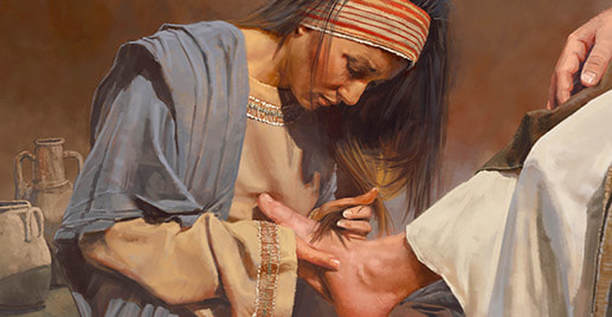But this confusion misses the fact that the different accounts may all represent the same anointing. For one thing, John does not say the woman anointed Jesus six days before Passover. What he says is: “Six days before the Passover, Jesus came to Bethany, where Lazarus lived, whom Jesus had raised from the dead. Here a dinner was given in Jesus’ honor” (John 12:1). John says Jesus came to Bethany six days before Passover, and that at some point while he was there a dinner was given in his honor. So there is no contradiction between the accounts of Matthew, Mark and John in this regard.
As for the account in Luke, that story does not say where the event took place – or when, though it is placed with other material from the early part of Jesus’ ministry. Although many presume that Luke’s “orderly” (Luke 1:3) account is chronological, it does, in fact, often stray from a chronological sequence. For example, in Luke 3 we read that King Herod shut John the Baptist up in prison (Luke 3:19-20), but then we read in the following verses that Jesus was baptized by John (Luke 3:21-22). In reality, of course, John baptized Jesus before being placed in prison (Matthew 3:1-17; 4:12; John 1:29-34). An even more striking example of “achronological” recording is seen at the end of Luke’s Gospel where he appears to compress the five weeks between the resurrection of Jesus and his ascension into a single day – if we treat what is said chronologically (compare Luke 24 with Matthew 28 and John 21).
As for differences in the anointing stories, they are small and easily explained. For example, Mathew and Mark say the woman anointed Jesus’ head; the other Gospels say his feet were anointed. But the woman may well have anointed Christ’s head and feet – recorded differently according to the stress the individual Gospel writers had in mind (for a kingly anointing, or an anointing for burial).
Luke’s account says the event occurred in the home of a Pharisee named Simon; the others say it was in the home of Simon the Leper in Bethany. But Simon the Leper and Simon the Pharisee were probably one and the same. A leper could never have hosted a dinner nor have partaken in one with other people – Simon the Leper must have been healed and could thus have been the same as Simon the Pharisee. Simon may well have been referred to as “the Pharisee” in Luke because Luke stresses Jesus’ reply to Simon’s pharisaical and self-righteous attitude, while the other Gospels remember him as Simon the Leper.
So there is no real reason why all the Gospel accounts could not be referring to the same thing. That being the case, consider the probability that they are, in fact, simply different accounts of the same event. It would be a strange coincidence if two different women (or more!) had gone to the house of a man called Simon, had anointed Jesus with exactly the same amount (300 denarii worth) of exactly the same kind of expensive perfume (nard), and had wiped his feet with their hair. If they were different women, why did the Gospel writers not differentiate them in some way? On the other hand, that Mary sister of Martha was the one woman who anointed Christ may perhaps be seen earlier in John’s account where he tells us: “(This Mary… was the same one who poured perfume on the Lord and wiped his feet with her hair.)” (John 11:2). Note that John says “the same one who” rather than “one of the women who.”
It would also be strange if not one of the four Gospel writers recorded both or all stories, if multiple similar events had occurred. This is especially true considering Jesus’ words in Mark 14:9: “Truly I tell you, wherever the gospel is preached throughout the world, what she has done will also be told, in memory of her.” Would Christ have put so much emphasis on this event if it was the second instance of two virtually identical cases? If this had been done by two different women, surely both would be clearly recorded.
Beyond these facts, we should remember that in John (12:4-5) we are told Judas complained that the perfume used to anoint Jesus was worth 300 denarii and the money could have been given to the poor, but is rebuked by Jesus who tells him to leave the woman alone as she has done a good work. In Matthew (26:9) and Mark (14:4) we are told that some of the disciples made exactly the same complaint (“300 denarii”) and were rebuked in the same way by Christ. Are we to believe that given identical circumstances, the disciples made exactly the same mistake after Jesus had already rebuked them for it just a few days before? It is much more reasonable to put the Gospel accounts together and to see that they probably refer, with differing details, to one dinner, one woman, one jar of perfume worth 300 denarii, and one anointing of Jesus.
Regardless of how many women were involved in these Gospel stories, however, they teach lessons that we can apply in our own lives. The attitude of love they exhibit is one we can all strive to imitate. How? Just as love was shown to Christ through the gift given for his physical body, we too can give gifts to the Body of Christ, which is his Church (Romans 12:5; 1 Corinthians 12:12–13; Ephesians 3:6, 5:23; Colossians 1:18, 24; etc.). The lessons of human love and godly forgiveness* that underlie these stories are ones which are indeed, timeless (Mark 14:9).
* Our article “Are Simon the Leper and Simon the Pharisee the Same? – and Why it Matters” shows a practical lesson we can all learn from these accounts, here.

 RSS Feed
RSS Feed
